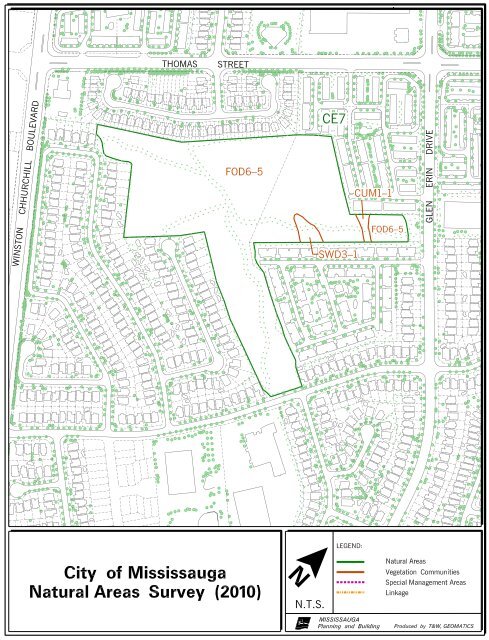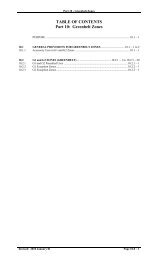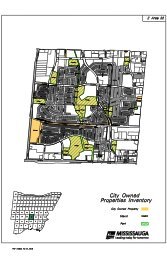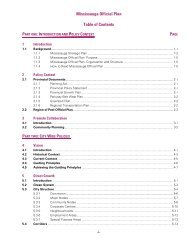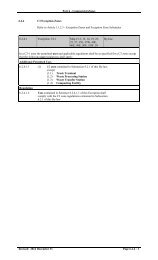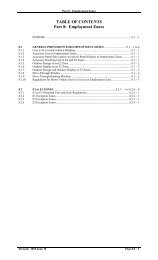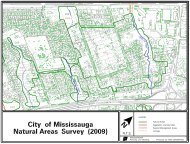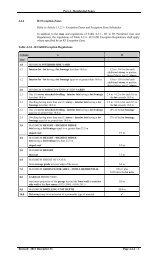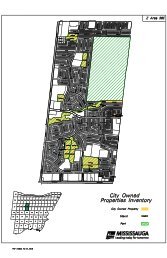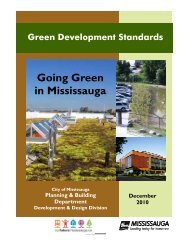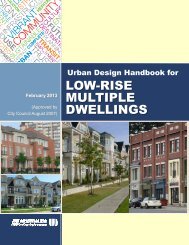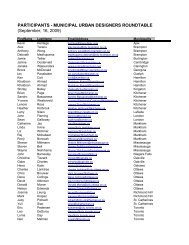Natural Areas Survey (NAS) Site: CE7 - City of Mississauga
Natural Areas Survey (NAS) Site: CE7 - City of Mississauga
Natural Areas Survey (NAS) Site: CE7 - City of Mississauga
- No tags were found...
Create successful ePaper yourself
Turn your PDF publications into a flip-book with our unique Google optimized e-Paper software.
<strong>City</strong> <strong>of</strong> <strong>Mississauga</strong> <strong>Natural</strong> <strong>Areas</strong> <strong>Survey</strong> (2010)<strong>Natural</strong> <strong>Areas</strong> Fact SheetNATURAL AREA NAMEPLANNING DISTRICTAREA (HA)UTM GRID REFERENCE<strong>CE7</strong> (Sugar Maple Woods)Central Erin Mills9.526027 482381. LOCATIONSouth <strong>of</strong> Thomas Street between Winston Churchill Boulevard and Glen Erin Drive. The natural areaCM12 is located approximately 500 m to the west.2. CLASSIFICATIONSignificant <strong>Natural</strong> <strong>Site</strong>3. DESCRIPTIONA. Physical FeaturesThis site is located in the Sawmill Creek subwatershed. Topography <strong>of</strong> this site is hilly and soil moisture ismesic to wet in swales. Seepage is apparent in many areas and a number <strong>of</strong> intermittent streams bisect thewoodlot. Many <strong>of</strong> these have culverts where they pass under gravel trails. Bedrock geology <strong>of</strong> the siteconsists <strong>of</strong> red shales <strong>of</strong> the Queenston Formation. These are buried by up to 7.5 m <strong>of</strong> soils and glacialdeposits consisting <strong>of</strong> poorly drained Jeddo clay loam, imperfectly drained Chinguacousy clay loam, andwell drained Oneida clay loam. The soils have developed in the Halton till deposits, <strong>of</strong> a partially bevelledtillplain.B. BiotaThere are 139 floral species and 18 faunal species documented for this site. Three vegetation communitiescomprise this site (see accompanying figure): a sugar maple (Acer saccharum ssp. saccharum) - Americanbeech (Fagus grandifolia) forest (DD) [fresh-moist sugar maple-hardwood deciduous forest type (FOD6-5)], old field (C) [dry-fresh old field meadow type (CUM1-1)], and silver maple (Acer saccharinum) forest(AA) [silver maple mineral deciduous swamp (SWD3-1)].The forest occupies the largest portion <strong>of</strong> the site. The willow-sedge community occurs where theintermittent streams bisects the woodlot. The intermittent stream at the east end <strong>of</strong> the natural area issurrounded by cultural meadow species. There is a sparse canopy above which consists <strong>of</strong> the occasionalcottonwood (Populus deltoides), with herbaceous vegetation below including: new-England aster(Symphyotrichum nova-angliae), Canada goldenrod (Solidago canadensis), bittersweet nightshade(Solanum dulcamara), and teasel (Dipsacus fullonum). The drainage channel travels down the east side <strong>of</strong>this community, and contains narrow-leaved cattail (Typha angustifolia). This drainage channel was dry inAugust <strong>of</strong> 2010.Sugar maple and American beech dominate this mature forest. The closed canopy has a height <strong>of</strong> 22 m.The canopy trees are approximately 80 years old and typically 39 cm in diameter, however, trees 70 cm indiameter are not unusual. Associate species are red oak (Quercus rubra) in the east, and white pine (Pinusstrobus) in the west. The sub-canopy contains sugar maple saplings and scattered hop hornbeam (Ostryavirginiana). The understorey is diverse and contains species such as large-leaved aster (Eurybiamacrophylla), Lady fern (Athyrium filix-femina), Solomon’s-seal (Polygonatum pubescens), maple-leavedviburnum (Viburnum acerifolium), and early meadow rue (Thalictrum dioicum).There is a small pocket <strong>of</strong> silver maple swamp located in a depression at the edge <strong>of</strong> the forest. Silvermaple is the dominant species in the canopy. There are no silver maple seedlings or saplings growing up
B. Biota (continued)to replace the aging canopy trees. There is no sub-canopy. The understory is sparse with only red-osierdogwood (Cornus stolonifera) in this layer. The ground layer is also sparsely vegetated with fowl mannagrass (Glyceria striata) and lake-bank sedge (Carex lacustris).There are 8 birds, 2 mammals, 6 amphibians, and 1 reptile documented at this site. This is a very lowdiversity considering that though small, the forest habitat is diverse, and the northern part <strong>of</strong> the site has aconfiguration with a low edge to interior ratio. The only species observed were habitat generalists such asnorthern cardinal, black-capped chickadee and American robin. Generally, minimal bird songs were heardin this natural area. One species moderately dependent on mature forest habitat was present: red-eyedvireo. However, this species can nest in a variety <strong>of</strong> forest habitats, including late successional forests andsmall patches. During the spring and fall migration periods, the diversity <strong>of</strong> birds is expected to increase asspecies utilize remnant natural areas as stopovers en route to breeding or wintering habitat.4. CONDITIONThis site is in fairly good condition. Disturbances present at this site include garbage, road noise, and pastlogging evidence. Gravel trails have been installed through this site, with culverts to maintain surfacewater connections. An old logging road passes through the central swale. Ad hoc trails have developed.The invasive plant species garlic mustard (Alliaria petiolata) has to spread into the woodlot. Forty-threeintroduced plant species are present at this site (representing 30.94% <strong>of</strong> the total number <strong>of</strong> speciespresent). The native FQI is 37.97, a medium value, which has increased from the 2006 value <strong>of</strong> 37.97.The native mean coefficient is 3.88 1 , a medium value, has decreased from the previous 2006 value <strong>of</strong> 4.09.Surrounding land use is residential.5. SIGNIFICANCE Butternut (Juglans cinerea) considered a “species at risk” within the province (COSSARO) andnationally (COSEWIC) is documented from this site. Butternut was not observed in 2010. Five plant species documented from this site are considered locally significant within the <strong>City</strong> (knownfrom 4 to 10 locations). These species are: the sedges (Carex cephalophora, C. retrorsa, C.plantaginea, and C. stricta), black ash (Fraxinus nigra), and downy arrow-wood (Viburnumrafinesquianum). 27 Credit Valley Conservation flora Species <strong>of</strong> Conservation Concern (Tier 1-3). 7 Credit Valley Conservation fauna Species <strong>of</strong> Conservation Concern (Tier 1-3), including 1 bird and6 amphibians. Relatively high native mean coefficient value suggests high quality floral components still persist atthis site. Close proximity to natural area CM12. Large size (9.52 ha). Diversity <strong>of</strong> plant species (139 species). The willow-sedge swale is an uncommon vegetation community in the <strong>City</strong>.6. MANAGEMENT NEEDS Garlic mustard should be removed. As a large tableland woodlot, this site should be a priority for a Conservation Plan.7. PRINCIPLE REFERENCES<strong>City</strong> <strong>of</strong> <strong>Mississauga</strong> (1978)duToit Associates Limited and Ecoplans Limited (1977)Ecoplans Limited (1981a)Proctor & Redfern Limited (1992)
1 Floristic quality is explained in the method section (2.3).


